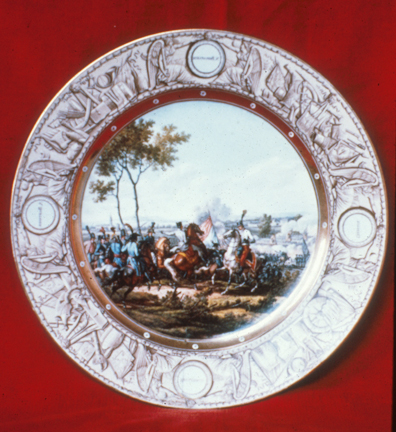The collapse of the French monarchy was very troubling for other crowned heads in Europe who now had just cause to fear for their own. Remember that Marie Antoinette, originally from Austria, became wife of Louis XVI and Queen of France and had been executed. Austria pledged assistance to their ally and sent troops to battle the revolutionary forces to reinstate the monarchy in France. The original impetus behind Napoleon's commanding the revolutionary army was to defend France's newly forming people's government against these incursions. The plate commemorates one of the victories of Napoleon's forces against the Austrians. The Battle of Marengo took place near Marengo, in northern Italy on June 14, 1800, and was a major engagement of the French Revolutionary Wars. The Austrians had decided to send troops to help defend Louis XVI, and this led to a declaration of war against Austria by the forces led by Napoleon. The battle at Marengo at first seemed like a rout by the Austrians, with the French in full retreat, but a contingent of 10,000 reinforcements, mainly General Louis Desaix's corps allowed a furious French counterattack. Desaix was killed almost immediately, but his battalion forced the Austrians into headlong retreat. Austrian losses included about 7,500 killed and wounded and some 4,000 captured, while French losses totaled about 6,000. The next day the Austrian signed an armistice.The battle was a pivotal one for the French Revolutionary forces and Napoleon.
Bending with the shifts in the winds of power, Sèvres was commandeered by Napoleon Bonaparte to produce works glorifying the events of the French Revolutionary Wars such as this plate. Bonaparte's name is in each of the 4 circular medallions in the rim of the plate.

'Battle of Marengo,' Plate, Sèvres Porcelain, France, early 1800's CE,
Soft Paste Porcelain with overglaze enamel and luster


